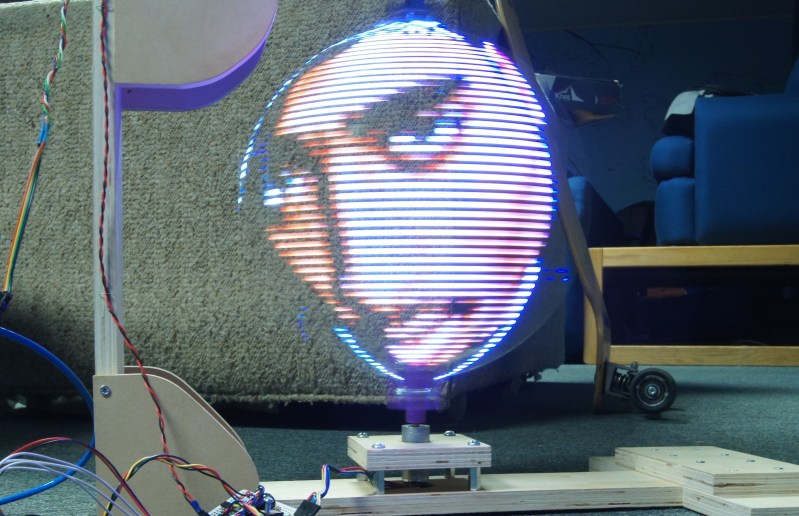Persistence of vision projects were once all the rage, judging by a quick review of the literature here on Hackaday. They’ve tapered off a bit lately, but this impressive full-color globe display might just kick-start some new POV projects.
Built as a final project for an EE course, [Evan] and [Kyle]’s project is more about the control electronics and programming than the mechanical end of the build. Still, spinning a 12″ ring of 1/4″ thick acrylic with a strip of APA102 LEDs glued to the edge takes some thoughtful engineering. While the build appears sturdy, [Evan] does admit to a bit of wobble under full steam, which was addressed by adding some weight to the rig. We wonder if mounting half the LEDs on each side of the ring to balance the forces wouldn’t have worked better. True, it would have complicated the coding for the display, but maybe that would have been good for extra points. In any case, the display turned out well and the quality of the images is great. And as an aside: how awesome is it that we live at a time when you can order a six-circuit slip-ring for a project like this for less than $20?
It’s the end of the semester and we love seeing the final projects that have just made it across the finish line. This globe is one, yesterday we saw a voice-controlled digital eye exam, and if you have or know of a final project, don’t forget send us the link!
If POV globes are your thing, be sure to set the Hackaday WABAC machine a few years and check out this Death Star design from 2012 or this globe from 2010.
















This is awesome. And a six-circuit slip-ring for a project like this for less than $20? Aah.. Another miracle from China.
You might want to use a radio instead of a slip ring to transfer the data. I got a cheap RP-Lidar which used a 4 circuit slip ring to pass data and power, but it failed after a few months of not-continuous use.
Or a rotary transformer, which can be salvaged from an old VCR.
You’d need a fair amount of bandwidth, latency would also be a problem. You could code around it, but you’d need the timing to be consistent, which might be a problem in packet-based radio.
You’d end up with so much hardware on the disc itself, you may as well just stick the controller on there. Which would show behind the LEDs and spoil the image. Reliability probably isn’t massively important, things like this are proofs of concept, or just fun. If it wears out, he can always order another slip ring, since he knows how it fits together. They’ll only cost $15 by then.
They are less than $7 if you cut out the middle man and get them directly from China-
http://www.aliexpress.com/item/12-5mm-300Rpm-6-Wires-6-Conductors-Capsule-Slip-Ring-240V-AC-for-Monitor-Robotic/2036431289.html?spm=2114.01020208.3.2.hdsBFQ&ws_ab_test=searchweb201556_7,searchweb201644_3_79_78_77_82_80_62_81,searchweb201560_3
Just search for “slip ring” on AliExpress. They have lots of different options.
I expect that, like all things in life, you can get good slip rings and not so good slip rings, and perhaps basing yourself on one bad experience isn’t the best way to go.
And with slip rings quality does matter and it’s easy to see how some manufacturer could put out a poor product. I mean just using the wrong material is so easy since the best contacts are made from precious metals and that drives up the cost and you can sell it with a poor material and it’ll seem good for long enough to not have too much hassle from dissatisfied customers.
Sad that there’s racism everywhere in tech…
Where?
I assumed that comment was a reply on a deleted comment.
@Whatnot: No comments have been deleted in this thread.
Could also run LEDs Around the whole ring, slightly offset and you’ll have an interlaced image that is twice as bright as it’s spinning, done right and you won’t even have gaps in the image. Added bonus of having the ring be a bit closer to balanced!